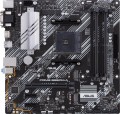Add to comparison |  |  |
|---|---|---|
| Asus PRIME B550M-A/CSM | Asus PRIME B550M-A | |
| Compare prices 6 | Compare prices 4 | |
| TOP sellers | ||
CSM is a model for corporate users. Customers of CSM products receive the ASUS Control Centre administration software. | ||
| Features | for home/office | for home/office |
| Socket | AMD AM4 | AMD AM4 |
| Form factor | micro-ATX | micro-ATX |
| Power phases | 8 | 8 |
| VRM heatsink | ||
| Size (HxW) | 244x244 mm | 244x244 mm |
Chipset | ||
| Chipset | AMD B550 | AMD B550 |
| BIOS | Ami | Ami |
| UEFI BIOS | ||
RAM | ||
| DDR4 | 4 slot(s) | 4 slot(s) |
| Memory module | DIMM | DIMM |
| Operation mode | 2 channel | 2 channel |
| Max. clock frequency | 4866 MHz | 4400 MHz |
| Max. memory | 128 GB | 128 GB |
| XMP | ||
Drive interface | ||
| SATA 3 (6Gbps) | 4 | 4 |
| M.2 connector | 2 | 2 |
| M.2 | 2xSATA/PCI-E 4x | 2xSATA/PCI-E 4x |
| M.2 version | 1x4.0, 1x3.0 | |
| Integrated RAID controller | ||
Expansion slots | ||
| 1x PCI-E slots | 2 | 2 |
| PCI-E 16x slots | 1 | 1 |
| PCI Express | 4.0 | 4.0 |
Internal connections | ||
| TPM connector | ||
| USB 2.0 | 2 | 2 |
| USB 3.2 gen1 | 1 | 1 |
| ARGB LED strip | 1 | 1 |
| RGB LED strip | 2 | 2 |
| More features | COM port | COM port |
Video outputs | ||
| D-Sub output (VGA) | ||
| DVI output | DVI-D | DVI-D |
| HDMI output | ||
| HDMI version | v.2.1 | v.2.1 |
Integrated audio | ||
| Audiochip | Realtek ALC887 | Realtek ALC887 |
| Sound (channels) | 7.1 | 7.1 |
Network interfaces | ||
| LAN (RJ-45) | 1 Gbps | 1 Gbps |
| LAN ports | 1 | 1 |
| LAN controller | Realtek RTL8111H | Realtek RTL8111H |
External connections | ||
| USB 3.2 gen1 | 4 | 4 |
| USB 3.2 gen2 | 2 | 2 |
| PS/2 | 1 | 1 |
Power connectors | ||
| Main power socket | 24 pin | 24 pin |
| CPU power | 8 pin | 8 pin |
| Fan power connectors | 4 | 4 |
| CPU Fan 4-pin | 2 | 1 |
| CPU/Water Pump Fan 4-pin | 1 | |
| Chassis/Water Pump Fan 4-pin | 2 | 2 |
| Added to E-Catalog | december 2021 | may 2020 |